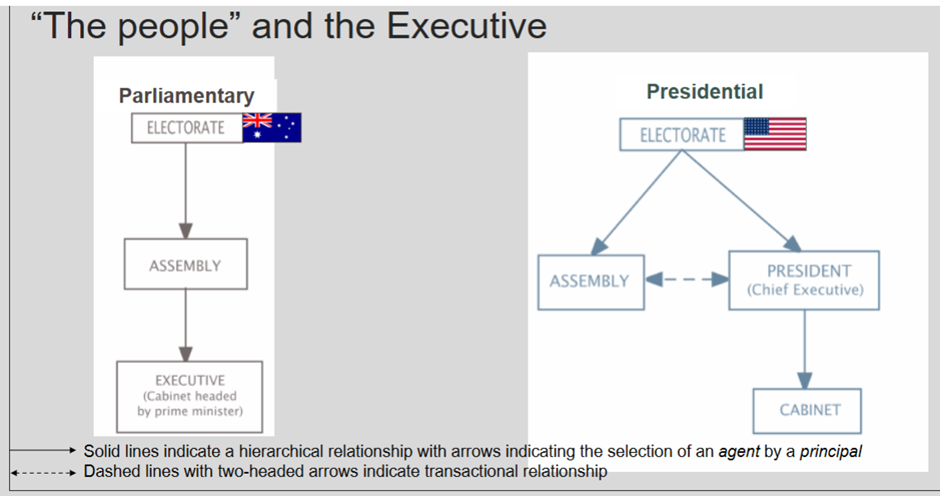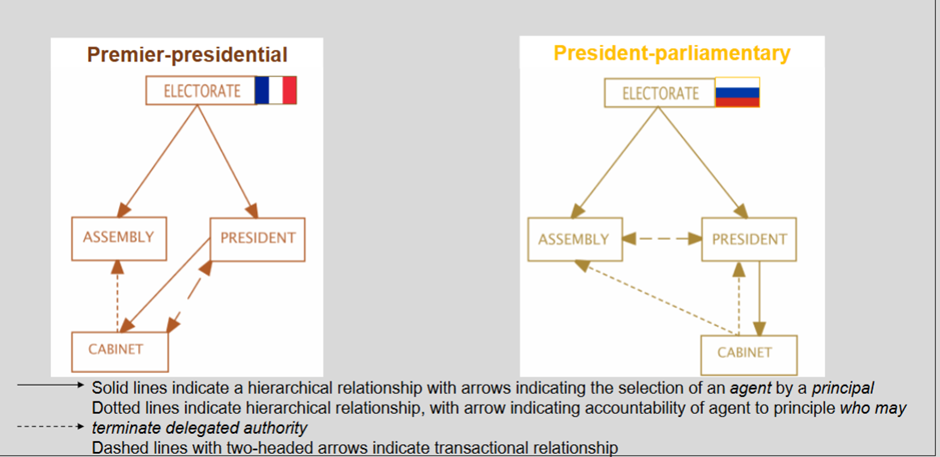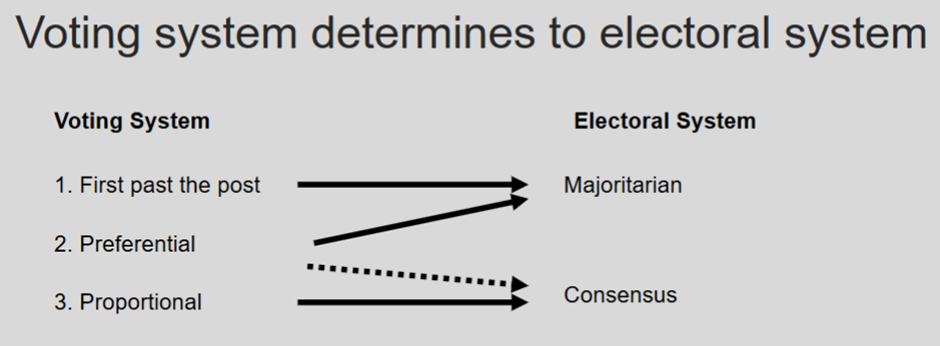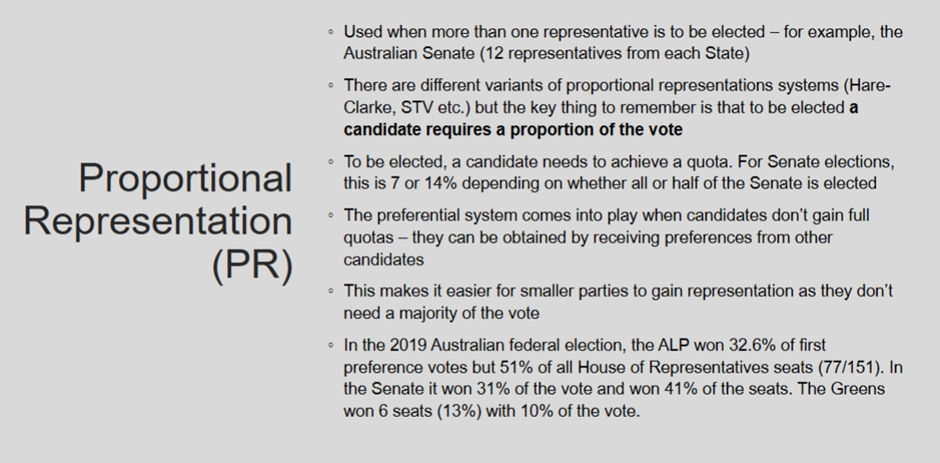the executive and legislature
1/69
There's no tags or description
Looks like no tags are added yet.
Name | Mastery | Learn | Test | Matching | Spaced |
|---|
No study sessions yet.
70 Terms
What are the three big reasons to study electoral systems?
a growing number of people specialise in electoral systems
electoral systems have become politically interesting
they define how the political system will function (they are the cogs that keep the wheels of democracy properly functioning
What is the primary function of electoral systems?
Ensuring the smooth running and accepted legitimacy of the system
What are some other functions of electoral systems?
Reflecting the wishes of voters
Producing strong and stable governments
Electing qualified individuals
What are some examples of electoral laws?
(These govern the process of the election)
laws on who can vote (citizens, residents, age,)
obliging citizens who turn out to vote (eg australia)
how citizens vote
the style of the ballot paper
What is a ‘proportional’ outcome electoral system?
Ensures the number of seats each party wins reflects as closely as possible the number of votes it has recieved
What is the essence of a non-proportional electoral system?
Greater importance is attached to ensuring that one party has a clear majority of seats over its competitors, increasing the prospect of strong and stable government
What does the ballot structure determine?
How voters cast their votes
What are the two types of ballots?
categorical ballots (either/or choice)
ordinal ballots (voters can vote for all candidates, ranking in order of preference)
What does a constitution do?
It sets out the rights of citizens and determines how the country will be governed, ie;
authoritarian/democratic
who will make the law and how? (legislature)
who will enforce the law and how? (executive)
How do we prevent the tyranny of the majority? “suppose a legislature duly representing public duty… drown all children born during the next two years”, the right to ignore the state
the separation of the powers
How do liberal democracies limit the tyranny of the majority, AKA, how do they enforce separation of power?
They divide power between:
the legislative branch (which makes the law)
the executive branch (which executes the law)
the judicial branch (which adjudicates and applies the law)
No one party or person controls all three elements.
The principle of federalism also supports the separation of power - power is divided between federal, state and sometimes local governments
How does the principle of federalism support the separation of power?
It divides power between federal, state and sometimes local governments.
Does Australia have seaparation of the power?
It has partial separation of power. The executive sits in the legislature. There are also regular opportunities to get rid of governments (short electoral terms)
What is the executive?
The top government tasked with decisions on how we govern. Consider COVID: deciding to close down or open borders.
What are the two roles of the executive government?
the executive government as ‘leadership’
head of state and head of government
sets policy and political direction
executive government as ‘executor’
mobilises support
resolves crises, makes decisions
oversees implementation
What is the head of the state?
The figurehead leader of the state who may be elected or appointed, or may inherit the position.
Australian example: the king, represented by the Australian governor general
What is the head of government?
the political leader of a government, elected or authoritarian leader. for example, prime minister Anthony Albanese
Are the head of state and head of government always separate?
No. Some do not have a distinction, for example in the USA. The figurehead of the state and political leader are inseparable
What are the similiarities of parliamentary and presidential democracy?
Personalisation
‘Chief diplomat’ and principle politician
Apex of beaurocracies
What are the differences of parliamentary and presidential governments?
Power over legislation
Origin, source of executive authority
Survival; accountability mechanisms
What do the relationship between ‘the people’ and executive look in parliamentary vs presidential?

What is semi-presidentialism? (hybrid system)
Divided/dual executive.
What are the key features of semi-presidentialism?
President
Popularly elected
non-trivial powers
has a say in composition of executive
Prime-minister and cabinet
Drawn from and accountable to elected legislature
What are the two subtypes of semi-presidentialism?
premier presidential (France)
president parliamentary (Russia)
What is the major issue with semi-presidentialism?
It makes it harder for political parties to work together
(ie, if Macron is centrist, the far left is the majority, a centrist leader will not be let in because the far left has the voting power)
According to Linz, what are the perils of presidentialism?
Elections are a zero-sum game (one winner)
Weaker partisan links with legislature, fewer coalition incentive, less cooperation, more potential gridlock
rival sources of legitimacy: legislature and executive
difficulties removing unpopular or corrupt leaders and lack of smooth executive succession
Depends on the qualities of the individual leader
More breakdown of democratic states in presidential regimes (especially Latin America)
‘While parliamentarism imparts flexibility to the political process, presidentialism makes it rather rigid’
How to distinguish between unitary and federal states?
In unitary states, the central government is in charge of running the entire country. In federations, the federal government but also state governments hold significant power.
Federal countries tend to be those that are larger, smaller countries (aside from China) tend to be unitary states
Arguments for decentralised government?
Gives citizens multiple points of access, enhancing opportunities for citizen participation (monitory democracy)
elected officials are held more accountable and responsive to citizens locally
accountability at local level lessens corruption
flexible policy learning
managerial efficiency
delivery of services can be tailored to local needs
can accommodate cultural autonomy in divided societies (eg religion, language)
What are some key features of parliamentary government that differs it from presidential?
prime minister is just a normal member of parliament
indirect election (by legislative majority)
executive: prime-minister and cabinet, collective executive
drawn from and/or directly responsible to an elected legislature/parliament
fused hierarchy of authority
accountability
legislative deadlocks within legislature
may include a monarch/monarch’s representative but these don’t have significant day-to-day powers
accountability comes from the party, the leader can be removed when confidence is lost
what are the key factors that differentiate a presidential from a parliamentary government?
president enjoys a national constituency
they are directly elected by the people and do not sit within congress
they do not have direct accountability to the legislature: a lot more complicated to remove (ie impeachment)
executive (president) and legislature separately elected
distributed authority
no direct accountability of executive to legislature
purer ‘separation of powers’
not removable by simple legislative vote
personalised executive
legislative deadlocks within legislature but also between legislature and executive
How do premier-presidential and president-parliamentary differ?

How does Lijphart differentiate presidential and parliamentary systems?
Presidential:
elected for a fixed term of office
popular (direct) election
one person executive with subordinate cabinet
Parliamentary:
Prime minister leads largest party
selected by party not by voters
Cabinet executive with collective responsibility
According to Dr Hefferman, why can’t a prime-minister be a president?
Prime ministers have more power due to less checks and balances
Prime ministers have more power
Presidents sit outside and negotiate with their party members in an attept to convince them to vote a certain way
According to Chohan and Jacobs, why are presidents interchangeable with prime ministers?
“Prime-ministers are gravitating towards a resemblance to presidential leaders”
personal control over power resources
autonomy
personalisation
According to Chohan and Jacobs what are the factors causing prime-ministers to resemble presidential leaders?
Internationalisation of politics
growth of the state
institutional machinery around prime minister
mass communications
Why does Schlesinger argue that the prime-minister and president are becoming interchangeable?
He quotes Nixon, “when the president does it, that means it’s not illegal”
WHY:
internationalisation of politics
foreign relations
war-making powers
Appointments functions
Courts
Bureaucracy
Circumvention of separation of powers (accountability
Refusing to respond to subpoenas from the legislature
‘Offshoring’ administrative activities
At the national and foreign policy level, there aren’t many checks and balances on the president. Their power is constrained in the domestic but not the international.
Arguments against decentralised government?
overlapping responsibilities reduces accountability
geographic inequalities reinforced (eg natural resource revenue)
maximises opportunities for corruption
managerial duplication, coordination costs, bureacratic inefficiencies
in divided societies, can encourage succession
effects may depend upon state boundaries
Key examples of federalism?
COVID-19:
State-led health response
border closures
What is a legislature?
A multi-member representative body which considers public issues and either accepts, amends or rejects proposals for new laws and policies
How does Norton (2013) define the legislature?
the one that ‘makes the law’ or at least ‘approve[s] measures that will form the law
What are the two major sub-types of legislature
Congresses and Parliaments
What are the functions of legislatures?
making laws
place of deliberation
source of governments
role of legislatures in democratic development
emphasis on ‘opposition rights’
source of accountability
representation
Some key areas of debate within representation within the legislature (ie parliament or congress)
Democratic theory tells us that legislatures should be elected by the people, which cements the ideas of popular rule and accountability. But who exactly are the people?
Indigenous Australians couldn’t participate until 1962, prisoners, those under 18?
Substantiative representation or collective representation? Should those affected by the policy be the only ones voting on it?
What are the various types of legislatures and electoral systems?
Parliament vs Congress
Majoritarian vs Consensus
Unicarmel vs Bicarmel
Compulsory Voting
Representation
What makes a legislature a ‘parliament’?
The executive (Prime minister and cabinet) is drawn from and/or directly responsible to an elected parliament,
right to select and dismiss the government (confidence)
‘fused’ executive
direct accountability (confidence)
legislative deadlocks within legislature
may include representation of monarch
What makes a legislature ‘a congress’?
The executive (president) and congress are separately elected:
Distributed authority
No direct accountability of executive to legislature (purer separation of powers)
legislative deadlocks within legislature but also between legislature and executive
does not ‘select’ government, limited rights to dismiss
What is the primary difference between definining a parliamentary or presidential system?
A parliament or congress. Both have legislatures but:
the sources and patterns of authority
executive accountability mechanisms
‘veto points’ for legislation
resilience and persistence of democratic regimes are greater in parliamentary systems (Linz)
How do majoritan representations work?
Party with the greatest support wins the seat
based on majority or plurality
How does proportional representation work?
proportion of seats will roughly equal the proportion of votes
What is majoritarianism usually characterised by?
concentration of executive power in one party only
executive-parliamentary relationships in which the executive is dominant
two-party systems
majoritarian, disproportional electoral systems
a pluralist system of pressure groups
(exaggerates the results, making it easier to pass laws. for example, labour won just 30%, but this was majority)
What are consensus systems characterised by? ie Germany?
power-sharing executives in multi-party coalitions, or minority governments that have to bargain to stay in power and pass laws
balance of power between the executive and the parliament
multi-party systems
a corporatist pressure group system
proportional representation
The majoritan system is favoured by those who believe:
there ought to be a single party government able to pass its legislation without major compromise and subsequently be evaluated and held accountable on its performance at election time
the consensus model is favoured by those who like to see:
broad participation in government; and tends to emphasise ‘inclusiveness, bargaining and compromise in government policy-making’
How does the voting system determine the electoral system?

How does first past the post electoral system work?
Voters mark their single preferred candidate
whoever gets the most votes is elected regardless of whether they reach the majority
the more candidates, the fewer votes needed to get the highest number
used in the UK and former colonies like USA
Has been criticised as undemocratic as government can form without majority of the vote
How does the preferential voting system work? (this is used in the lower house)
At the core of this system is the idea the winner needs to obtain the majority of votes.
The distribution of preferences comes into play when there are more than two candidates and no candidate has won an outright majority
The candidate with the lowest primary vote is eliminated and their preferences allocated.
This continues until a candidate gains a majority of votes.
What is proportional representation?

What is the washminster system?
Australia combines majoritarian votes in the lower house (westminster) with proportional in the upper house (Washington system).
Each electorate elects 1 MP who sits in the house of reps → leader of the party controls a majority in the house of reps becomes PM
What is unicameral legislature?
Earliest (non-democratic) parliaments were unicameral
What is a bicameral parliament?
Two houses/chambers
Majority of legislatures (60%)
No point if they are identical in composition
What is the difference between bicameral and unicameral legislature?
◦ Two elected houses elected by the same voters via different rule; e.g., local geographic communities for one house and a larger community (region; nation) for the other house.
◦ Democratic election for one house and non-
democratic selection for the other:
◦ People v aristocracy
◦ Conservatism
◦ Expertise
◦ Federalism
How does the strength of bicamerialism vary?
There are three main factors:
congruence of composition (slightly different pattern of people → more power)
symmetry (of powers)
legitimacy (of second house)
Australian houses:
incongruent, symmetrical, legitimate
strong bicamerialism like Australia leads to the problems of deadlocks
Weak bicameralism leads to the problem of relevance
Why is the size of a congress or parliament significant?
A key issue of representation, deliberation, accountability.
Relative to population (representation) but other considerations, eg policy capacity, communication between members
How long are presidents/politicians elected for?
In Australia, the typical length is from 3-6 years.
The length of a term corresponds with the frequency of elections
in making this decision, the need to balance accountability with time to properly legislate a program of action.
What are the advantages of compulsory voting?
electoral outcomes based on participation of all citizens
greater representation in policy making of those groups that would be less likely to vote if voluntary
less money needed to get people out to vote
disadvantages of compulsory voting?
political parties don’t need to mobilise voters
lazy political parties
little incentive to recruit party members
advantages of voluntary voting?
right not to vote
parties need to mobilise voters
Disadvantages of voluntary voting
certain groups disproportionately don’t turn out to vote including;
young people
ethnic minorities
lower-socio economic status
parties more likely to appeal to extreme views
groups that don’t vote are less likely to be represented in policy making
What are some approaches to improving women’s representation?
do nothing - rely on broad social trends (approach taken by libs)
voluntary party quotas - parties place quotas on their own parties
parliamentary legislative quotas
According to Linz, why does presidentialism present higher risk of political instability and regime collapse?
in electoral democracies with presidential regimes, both parliaments and presidents have rival sources of popular legitimacy and authority, making it difficult to resolve disputes.
Presidents hold office for a fixed term, reducing flexibility.
Presidential elections are winner take all, raising the stakes and generating weak incentives for the losers to accept the legitimacy of the outcome.
And the fusion of the offices of head of state and head of the government may reduce restraints on political leaders arising from checks and balances.